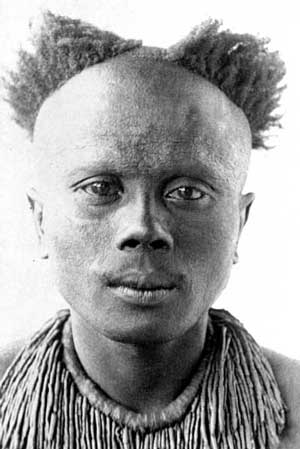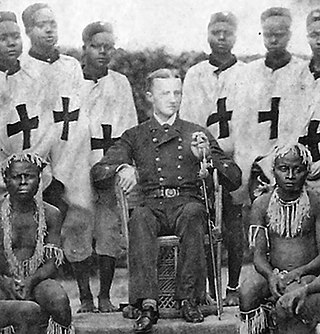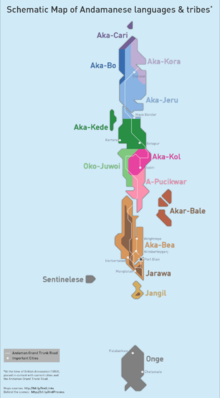
The Andamanese languages are a pair of language families spoken by the Andamanese peoples of the Andaman Islands in the Indian Ocean. The two language families are Great Andamanese and Ongan, while the Sentinelese language is spoken by an uncontacted people and therefore at present unclassifiable.

The Pucikwar language, A-Pucikwar, is an extinct language of the Andaman Islands, India, formerly spoken by the Pucikwar people on the south coast of Middle Andaman, the northeast coast of South Andaman, and on Baratang Island. It belonged to the Great Andamanese family.
The Pucikwar were one of the indigenous peoples of the Andaman Islands, one of the ten or so Great Andamanese tribes identified by British colonials in the 1860s. They spoke a distinctive Pucikwar language (A-Pucikwar) closely related to the other Great Andamanese languages. The tribe disappeared as a distinct group sometime after 1931.

The Sentinelese, also known as the Sentineli and the North Sentinel Islanders, are an indigenous people who inhabit North Sentinel Island in the Bay of Bengal in the northeastern Indian Ocean. Designated a Particularly Vulnerable Tribal Group and a Scheduled Tribe, they belong to the broader class of Andamanese peoples.

The Andamanese are the indigenous peoples of the Andaman Islands, part of India's Andaman and Nicobar Islands union territory in the southeastern part of the Bay of Bengal in Southeast Asia. The Andamanese peoples are among the various groups considered Negrito, owing to their dark skin and diminutive stature. All Andamanese traditionally lived a hunter-gatherer lifestyle, and appear to have lived in substantial isolation for thousands of years. It is suggested that the Andamanese settled in the Andaman Islands around the latest glacial maximum, around 26,000 years ago.

The Great Andamanese are an indigenous people of the Great Andaman archipelago in the Andaman Islands. Historically, the Great Andamanese lived throughout the archipelago, and were divided into ten major tribes. Their distinct but closely related languages comprised the Great Andamanese languages, one of the two identified Andamanese language families.

The Onge are an Andamanese ethnic group, indigenous to the Andaman Islands in Southeast Asia at the Bay of Bengal, currently administered by India. They are traditionally hunter-gatherers and fishers, but also practice plant cultivation. They are designated as a Scheduled Tribe of India.

The Bale language, Akar-Bale, is an extinct Southern Great Andamanese language once spoken in the Andaman Islands in Ritchie's Archipelago, Havelock Island, and Neill Island.
The Jarawas are an indigenous people of the Andaman Islands in India. They live in parts of South Andaman and Middle Andaman Islands, and their present numbers are estimated at between 250–400 individuals. They have largely shunned interaction with outsiders, and many particulars of their society, culture and traditions are poorly understood. Since the 1990s, contacts between Jarawa groups and outsiders grew increasingly frequent. By the 2000s, some Jarawas had become regular visitors at settlements, where they trade, interact with tourists, get medical aid, and even send their children to school.
Strait Island is an island of the Andaman Islands. It belongs to the North and Middle Andaman administrative district, part of the Indian union territory of Andaman and Nicobar Islands. The island lies 63 km (39 mi) north from Port Blair.

The Great Andamanese languages are a nearly extinct language family once spoken by the Great Andamanese peoples of the northern and central Andaman Islands in the Indian Ocean, and part of Andamanese sprachbund.

The Kede language, Aka-Kede, is an extinct Great Andamanese language, of the Northern group. It was spoken in the Northern section of Middle Andaman island.

The Bo language, Aka-Bo, was a Great Andamanese language. It was spoken on the west central coast of North Andaman and on North Reef Island of the Andaman Islands in India.

The Cari, Chariar or Sare language, also known as Aka-Cari, is an extinct Great Andamanese language, of the Northern group, which was spoken by the Cari people, one of a dozen Great Andamanese peoples.

The Kora (Cora) language, Aka-Kora, is an extinct Great Andamanese language, of the Northern group. It was spoken on the northeast and north central coasts of North Andaman and on Smith Island.

The Bo were one of the ten indigenous tribes of the Great Andamanese people, originally living on the western coast of North Andaman Island in the Indian Ocean.
North Brother Island is an uninhabited island in the Indian Ocean, part of the Andaman Archipelago. It is located in the Duncan Passage, about 19 kilometre northeast of Little Andaman Island. It is part of the South Andaman district of the Andaman and Nicobar Islands, a Union Territory of India.
South Brother Island is an uninhabited island in the Indian Ocean, part of the Andaman Archipelago. It is located in the Duncan Passage, about 9.5 kilometre northeast of Little Andaman Island. It is part of the South Andaman district of the Andaman and Nicobar Islands, a Union Territory of India.

Maurice Vidal Portman was a British naval officer, who is best known for documenting several Andamanese tribes between 1879 and 1901 when he was posted as a superintendent of the Andaman Island Penal Colony.

The Kora, Khora or Cora were one of the ten indigenous tribes of the Great Andamanese people, originally living on the eastern part of North Andaman Island in the Indian Ocean. The tribe is now extinct, although some of the remaining Great Andamanese on Strait Island claim to have Kora ancestors.






